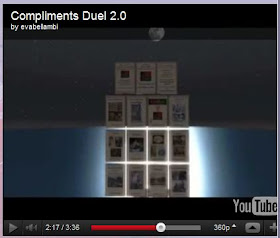Can Google help me discover *why* this is the "Colonel Exrex Somme" reference collection? It appears that the compliment was presented, with dramatic timing and visual presentation at the second Compliments Duel on May 11, 2008.
[15:29]-[15:37] JJ Drinkwater:
I am so stunned by the Colonel's politesse, as well as by his hats, that I am, for the moment, at a loss for words
pretends to think
It is true, sir, that in a land of magnanimous spirit, as this, our Caledon, we rise as we are able
And yet, it is not only those who are poor who are honest, nor yet only those of humble origins who exemplify Nature's Nobility
And, as I have repeatedly said, here today and on many another ocassion
Your love of learning do you the most irreproachable credit
As I am at a loss for words, I think I must let pictures tell, in the main, my story....
As you know, it is the custom of the Caledon library to name its brances and, when possible, its collections, after persons of note
viz the Marie Curie and HG Wells memroial branches
And the Ellen Throckmorton Etiquette collection
Now, the glory of the Caledon library (second only to its patrons and supporters) is its collections
And when we went to name our Reference Collection
We felt that we must name it for someone of suitably compendious learning, and widespread intellectual curiosity
Which is why, sir, we could do no better that to create....
The Colonel Exrex Somme Reference Collection
However, the decision won't have been made on the spot, so I wonder whether the whole compliment was planned long ahead... or ?
I love that the Colonel Exrex Somme Reference Collection is searchable with a Custom Google Search (sorry: Caledon Library Aetheric Search Gizmo).
As to browsing the collection (be careful this could take hours... I was drawn in to Roger Vaughan's Victorian & Edwardian Photography Collection, fascinated by the compilation and the sharing of information to trace old photos). But back to the Col. Exrex Somme collection, it is built within a blog with each category in a blog "post", and each resource is annotated. There are not too many categories -- what is "too many"? -- the compact presentation may avoid the appearance of "too many". Perception of "too many" often prevents me browsing reference collections. At each category, breadcrumb trail would be preferable (more easily recognised) for navigation over the "Click back" to main at the bottom of the category.
Of course I'm dreadfully curious whether the library uses aetheric means to track/quantify usage of those links; and whether Google feeds them an account of searches conducted?
Maintenance must be a nuisance, how big is the team maintaining it (and TheLibraryMilitant)? Among the browsables Caledon,
- "SL Steampunk Blogs - Zoe Connolly's links and reviews of blogs covering Caledon..." no longer exists.
All of this discovery followed from one sign amongst the Steampunk Collection up on the Dirigible. So what does it mean to my research into Second Life-ly librarianship? It interestingly demonstrates:
- collection development focussed on the sim's theme - a well-recognised point
- and admirable use of collaborative/interactive tools.




